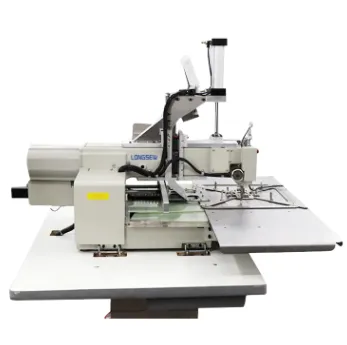Automatic Pattern Sewing Machine: Unlocking New Possibilities with CNC Sewing Technology
The rise of the automatic pattern sewing machine powered by CNC sewing technology marks a significant milestone in textile manufacturing. These machines offer unprecedented accuracy, repeatability, and efficiency by automating complex stitching patterns and reducing human error. Whether utilized as a CNC quilting machine, CNC upholstery sewing machine, or in large-scale production with an industrial CNC sewing machine, this technology reshapes how manufacturers approach sewing tasks—making production faster, more precise, and more cost-effective.

How CNC Sewing Machines Work
At its core, a CNC sewing machine uses computer numerical control to guide the needle and fabric through intricate stitching paths programmed via specialized software. This automation allows for complex designs that would be difficult or impossible to achieve manually. The machine’s ability to follow exact coordinates ensures consistent stitch length, pattern repetition, and seam quality, key factors for maintaining product standards in competitive markets.
Applications of CNC Sewing Machines in Industry
Different sectors benefit from the versatility of CNC sewing technology. The CNC quilting machine is widely used in bedding and mattress manufacturing, where detailed quilting patterns not only enhance aesthetics but also improve product durability. Upholstery manufacturers rely on the CNC upholstery sewing machine to handle heavy fabrics and complex contours, producing consistent seams that meet both functional and decorative needs.
The industrial CNC sewing machine offers robustness and speed, engineered to run continuously in demanding production environments. Companies looking for a CNC sewing machine for sale often evaluate these models for their balance of automation, ease of use, and maintenance support.
Pricing and Selection Considerations
When considering CNC sewing machine price, it’s important to assess the total cost of ownership, including software licensing, training, and after-sales service. While upfront investment may be higher compared to conventional machines, the gains in productivity, precision, and waste reduction often justify the expense. Selecting the right CNC machine also involves evaluating the types of fabrics to be sewn, the complexity of the patterns, and the scale of production.
The Future of CNC Stitching in Textile Manufacturing
With advances in digital design and automation, CNC stitching machines continue to evolve, integrating with Industry 4.0 systems and enabling smart manufacturing. The capability to quickly reprogram patterns and automate quality checks is streamlining workflows and enabling more customized production runs. As technology advances, the role of the automatic pattern sewing machine in textile innovation will only grow stronger.
In summary, automatic pattern sewing machines equipped with CNC sewing capabilities represent the forefront of modern sewing technology. Whether through industrial CNC sewing machines, CNC quilting machines, or CNC upholstery sewing machines, manufacturers gain precision, speed, and adaptability to meet diverse production challenges. Understanding pricing, machine features, and applications helps businesses make informed investments that drive quality and efficiency in textile manufacturing.
-
Automatic Pattern Sewing Machine: Enhancing Efficiency with Advanced CNC Sewing SolutionsNewsAug.26,2025
-
Automatic Pattern Sewing Machine: Revolutionizing Textile Manufacturing with CNC TechnologyNewsAug.26,2025
-
Lock Stitch Sewing Machine: Precision and Performance in Industrial StitchingNewsAug.26,2025
-
Lock Stitch Sewing Machine: Enhancing Efficiency with Advanced Stitching TechnologyNewsAug.26,2025
-
Lock Stitch Sewing Machine: Advancing Sewing Technology for Industrial ExcellenceNewsAug.26,2025
-
Lock Stitch Sewing Machine: Essential Technology for Precision StitchingNewsAug.26,2025
-
Precision and Durability with Auto Upholstery Sewing MachinesNewsAug.26,2025


























